副词从句(状语从句)
状语从句如何使用副词从句来描述动作或状态
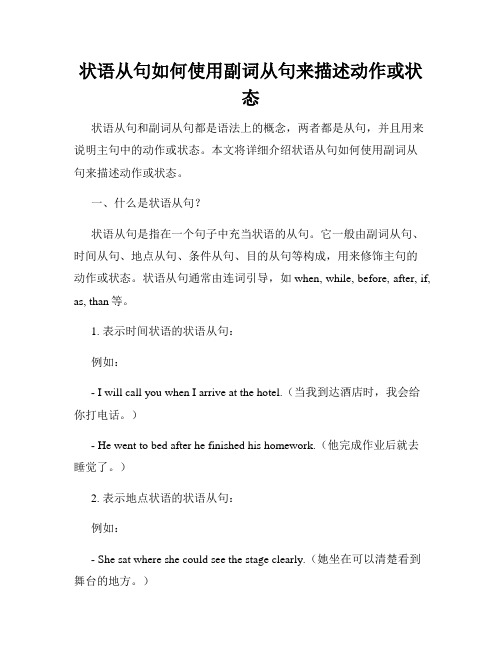
状语从句如何使用副词从句来描述动作或状态状语从句和副词从句都是语法上的概念,两者都是从句,并且用来说明主句中的动作或状态。
本文将详细介绍状语从句如何使用副词从句来描述动作或状态。
一、什么是状语从句?状语从句是指在一个句子中充当状语的从句。
它一般由副词从句、时间从句、地点从句、条件从句、目的从句等构成,用来修饰主句的动作或状态。
状语从句通常由连词引导,如when, while, before, after, if, as, than等。
1. 表示时间状语的状语从句:例如:- I will call you when I arrive at the hotel.(当我到达酒店时,我会给你打电话。
)- He went to bed after he finished his homework.(他完成作业后就去睡觉了。
)2. 表示地点状语的状语从句:例如:- She sat where she could see the stage clearly.(她坐在可以清楚看到舞台的地方。
)- He met his friend at the place where they used to hang out.(他在他们经常出去的地方见到了他的朋友。
)3. 表示条件状语的状语从句:例如:- If it rains tomorrow, we will stay at home.(如果明天下雨,我们会呆在家里。
)- He can join us as long as he finishes his work in time.(只要他准时完成工作,他就可以和我们一起来。
)二、副词从句如何描述动作或状态?副词从句是指在一个句子中充当副词的从句,它用来修饰动词、形容词、副词等。
副词从句通常由连词引导,如how, when, where, why, if等。
1. 描述方式、方式、原因的副词从句:- He explained how he solved the math problem.(他解释了他如何解决这个数学问题。
英语语法之副词从句(一)
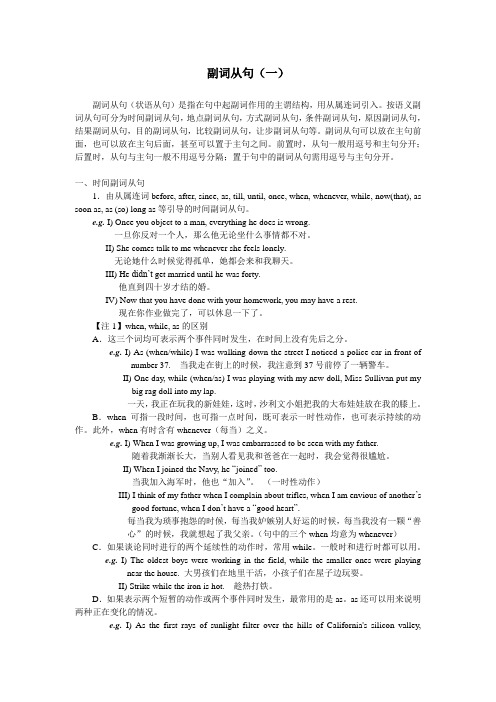
副词从句(一)副词从句(状语从句)是指在句中起副词作用的主谓结构,用从属连词引入。
按语义副词从句可分为时间副词从句,地点副词从句,方式副词从句,条件副词从句,原因副词从句,结果副词从句,目的副词从句,比较副词从句,让步副词从句等。
副词从句可以放在主句前面,也可以放在主句后面,甚至可以置于主句之间。
前置时,从句一般用逗号和主句分开;后置时,从句与主句一般不用逗号分隔;置于句中的副词从句需用逗号与主句分开。
一、时间副词从句1.由从属连词before, after, since, as, till, until, once, when, whenever, while, now(that), as soon as, as (so) long as等引导的时间副词从句。
e.g. I) Once you object to a man, everything he does is wrong.一旦你反对一个人,那么他无论坐什么事情都不对。
II) She comes talk to me whenever she feels lonely.无论她什么时候觉得孤单,她都会来和我聊天。
III) He didn’t get married until he was forty.他直到四十岁才结的婚。
IV) Now that you have done with your homework, you may have a rest.现在你作业做完了,可以休息一下了。
【注1】when, while, as的区别A.这三个词均可表示两个事件同时发生,在时间上没有先后之分。
e.g. I) As (when/while) I was walking down the street I noticed a police car in front ofnumber 37. 当我走在街上的时候,我注意到37号前停了一辆警车。
II) One day, while (when/as) I was playing with my new doll, Miss Sullivan put mybig rag doll into my lap.一天,我正在玩我的新娃娃,这时,沙利文小姐把我的大布娃娃放在我的膝上。
副词状语从句
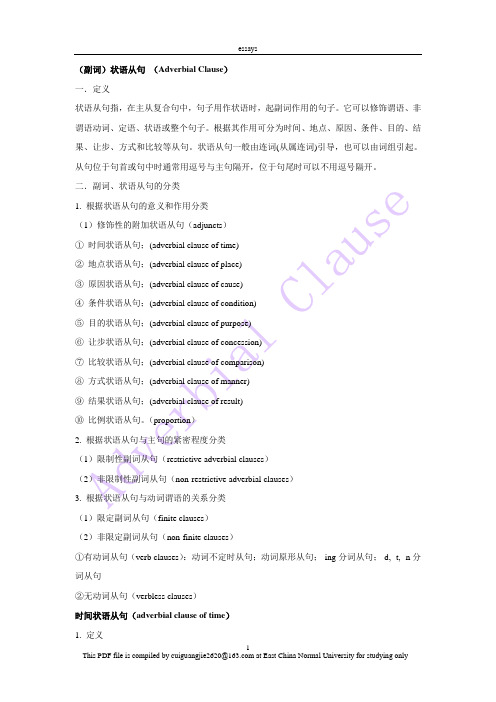
(副词)状语从句(Adverbial Clause)一.定义状语从句指,在主从复合句中,句子用作状语时,起副词作用的句子。
它可以修饰谓语、非谓语动词、定语、状语或整个句子。
根据其作用可分为时间、地点、原因、条件、目的、结果、让步、方式和比较等从句。
状语从句一般由连词(从属连词)引导,也可以由词组引起。
从句位于句首或句中时通常用逗号与主句隔开,位于句尾时可以不用逗号隔开。
二.副词、状语从句的分类1. 根据状语从句的意义和作用分类(1)修饰性的附加状语从句(adjuncts)①时间状语从句;(adverbial clause of time)②地点状语从句;(adverbial clause of place)③原因状语从句;(adverbial clause of cause)④条件状语从句;(adverbial clause of condition)⑤目的状语从句;(adverbial clause of purpose)⑥让步状语从句;(adverbial clause of concession)⑦比较状语从句;(adverbial clause of comparison)⑧方式状语从句;(adverbial clause of manner)⑨结果状语从句;(adverbial clause of result)⑩比例状语从句。
(proportion)2. 根据状语从句与主句的紧密程度分类(1)限制性副词从句(restrictive adverbial clauses)(2)非限制性副词从句(non-restrictive adverbial clauses)3. 根据状语从句与动词谓语的关系分类(1)限定副词从句(finite clauses)(2)非限定副词从句(non-finite clauses)①有动词从句(verb clauses):动词不定时从句;动词原形从句;-ing分词从句;-d, -t, -n分词从句②无动词从句(verbless clauses)时间状语从句(adverbial clause of time)1. 定义在复合句中,由时间连接词引导的状语从句叫做时间状语从句。
副词性从句经典

03
tomorrow:明天
04
yesterday:昨天
时间状语从句的引导词
when:当...时 whenever:无论什么时候
as:一边...一边
时间状语从句的引导词
while:在...期间 before:在...之前
after:在...之后
时间状语从句的引导词
until
直到...为止
since
特点
副词性从句不能独立成句,需要依附于主句存在;从句中的引导词起到连接主句和从句的作用,状语从句
表示动作发生的时间,如“when”、“while”、 “as”等引导的从句。
地点状语从句
表示动作发生的地点,如“where”、“wherever”等 引导的从句。
while:虽然,尽管(用于对比) in spite of:尽管,不管
让步状语从句的引导词
引导词+主语+谓语
01
Although he is young, he knows a lot. 尽管他年轻,但他懂
得很多。
引导词+谓语+主语
02
Though lacking money, they managed to open the
既然
表示已知前述情况为真,那么可 以推断出后续的结论或结果。
原因状语从句的语序与翻译
语序
在汉语中,原因状语从句通常放在主句之前,表示先因后果的关系。在英语中,原因状语从句可以放在主句之前 或之后,语序相对灵活。
翻译
在将原因状语从句翻译成英语时,需要根据英语的表达习惯进行调整。如果原因状语从句较短,可以将其翻译成 英语中的原因状语短语;如果较长或需要强调原因,可以将其翻译成英语中的原因状语从句,并使用适当的引导 词进行连接。
副词性从句作状语和宾语补足语
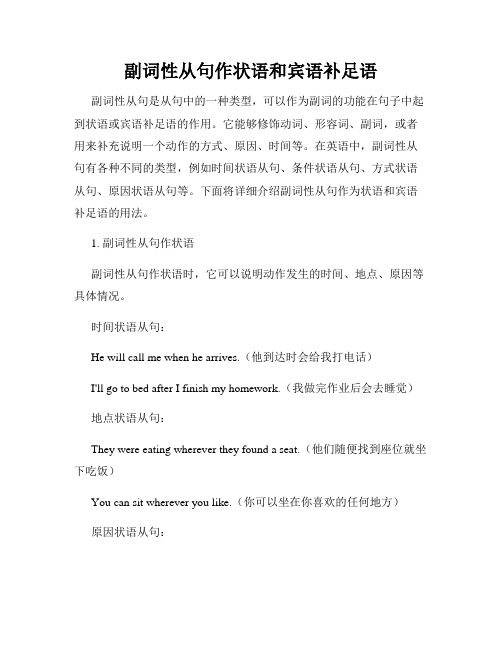
副词性从句作状语和宾语补足语副词性从句是从句中的一种类型,可以作为副词的功能在句子中起到状语或宾语补足语的作用。
它能够修饰动词、形容词、副词,或者用来补充说明一个动作的方式、原因、时间等。
在英语中,副词性从句有各种不同的类型,例如时间状语从句、条件状语从句、方式状语从句、原因状语从句等。
下面将详细介绍副词性从句作为状语和宾语补足语的用法。
1. 副词性从句作状语副词性从句作状语时,它可以说明动作发生的时间、地点、原因等具体情况。
时间状语从句:He will call me when he arrives.(他到达时会给我打电话)I'll go to bed after I finish my homework.(我做完作业后会去睡觉)地点状语从句:They were eating wherever they found a seat.(他们随便找到座位就坐下吃饭)You can sit wherever you like.(你可以坐在你喜欢的任何地方)原因状语从句:They went home because it was raining heavily.(因为下大雨,他们回家了)She smiled as she saw her friend.(她看见朋友时笑了)方式状语从句:He learns English as if he were a native speaker.(他学英语的方式像是一个母语者)She opened the door as though nothing had happened.(她打开门好像什么都没发生过)条件状语从句:If it rains tomorrow, we will stay at home.(如果明天下雨,我们会呆在家里)I'll lend you the money provided that you pay me back next week.(只要你下周还我钱,我就借给你)2. 副词性从句作宾语补足语副词性从句还可以作为宾语补足语,对于某些表示思考、感觉、告知、建议等的动词起到补充说明的作用。
副词从句和状语从句的区别与运用
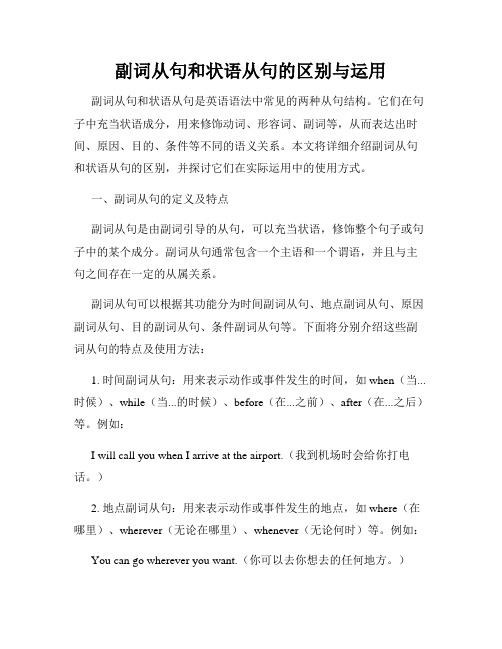
副词从句和状语从句的区别与运用副词从句和状语从句是英语语法中常见的两种从句结构。
它们在句子中充当状语成分,用来修饰动词、形容词、副词等,从而表达出时间、原因、目的、条件等不同的语义关系。
本文将详细介绍副词从句和状语从句的区别,并探讨它们在实际运用中的使用方式。
一、副词从句的定义及特点副词从句是由副词引导的从句,可以充当状语,修饰整个句子或句子中的某个成分。
副词从句通常包含一个主语和一个谓语,并且与主句之间存在一定的从属关系。
副词从句可以根据其功能分为时间副词从句、地点副词从句、原因副词从句、目的副词从句、条件副词从句等。
下面将分别介绍这些副词从句的特点及使用方法:1. 时间副词从句:用来表示动作或事件发生的时间,如when(当...时候)、while(当...的时候)、before(在...之前)、after(在...之后)等。
例如:I will call you when I arrive at the airport.(我到机场时会给你打电话。
)2. 地点副词从句:用来表示动作或事件发生的地点,如where(在哪里)、wherever(无论在哪里)、whenever(无论何时)等。
例如:You can go wherever you want.(你可以去你想去的任何地方。
)3. 原因副词从句:用来表示某种原因或理由,如because(因为)、since(既然)、as(由于)等。
例如:He couldn't come to the party because he was sick.(他因为生病不能参加派对。
)4. 目的副词从句:用来表示动作或意图的目的,如so that(以便)、in order that(为了)等。
例如:I brought my umbrella so that I won't get wet in the rain.(我带了伞,以便在雨中不被淋湿。
)5. 条件副词从句:用来表示某一条件下会发生的情况,如if(如果)、unless(除非)、as long as(只要)等。
专四语法讲解(状语从句)
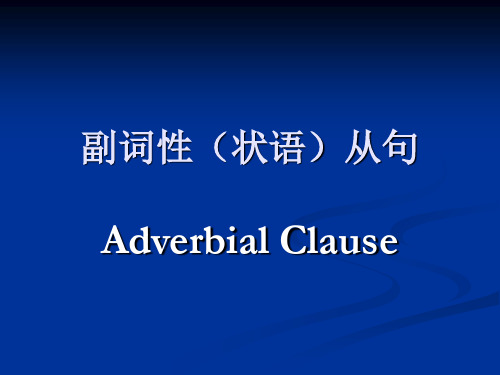
A. being treated
B. treated
C. be treated
D. having been treated
[B]
3. _____ both sides accept the agreement _____ a lasting peace be established in this region. (04, 60)
[B]
3.时间状语从句 Adverbial Clause of Time
(1)when , while; after; before; as; as soon as; once; until; whenever等引导的时间状语 从句
eg. My husband was doing washing at home while I was out shopping.
Suppose it rained, we would still go. (假 如……)
Say it were true, what would you do about it? (假如……)
从句的省略。当条件状语从句的主语与主句主语 一致,并且从句谓语含有be时,可以将从句主语 和be一起省略。 这被称为带连词的无动词状语从 句。
In the event that she has not been informed, I will tell her. (如果……)
You can go swimming on condition that you don’t go too far from the river bank. (如 果……)
A. on occasion
B. on purpose
C. on condition D. only if
副词从句

副词从句(一)副词从句(状语从句)是指在句中起副词作用的主谓结构,用从属连词引入。
按语义副词从句可分为时间副词从句,地点副词从句,方式副词从句,条件副词从句,原因副词从句,结果副词从句,目的副词从句,比较副词从句,让步副词从句等。
副词从句可以放在主句前面,也可以放在主句后面,甚至可以置于主句之间。
前置时,从句一般用逗号和主句分开;后置时,从句与主句一般不用逗号分隔;置于句中的副词从句需用逗号与主句分开。
一、时间副词从句1.由从属连词before, after, since, as, till, until, once, when, whenever, while, now(that), as soon as, as (so) long as等引导的时间副词从句。
e.g. I) Once you object to a man, everything he does is wrong.一旦你反对一个人,那么他无论坐什么事情都不对。
II) She comes talk to me whenever she feels lonely.无论她什么时候觉得孤单,她都会来和我聊天。
III) He did n’t get married until he was forty.他直到四十岁才结的婚。
IV) Now that you have done with your homework, you may have a rest.现在你作业做完了,可以休息一下了。
【注1】when, while, as的区别A.这三个词均可表示两个事件同时发生,在时间上没有先后之分。
e.g. I) As (when/while) I was walking down the street I noticed a police car in front of number 37. 当我走在街上的时候,我注意到37号前停了一辆警车。
副词性从句
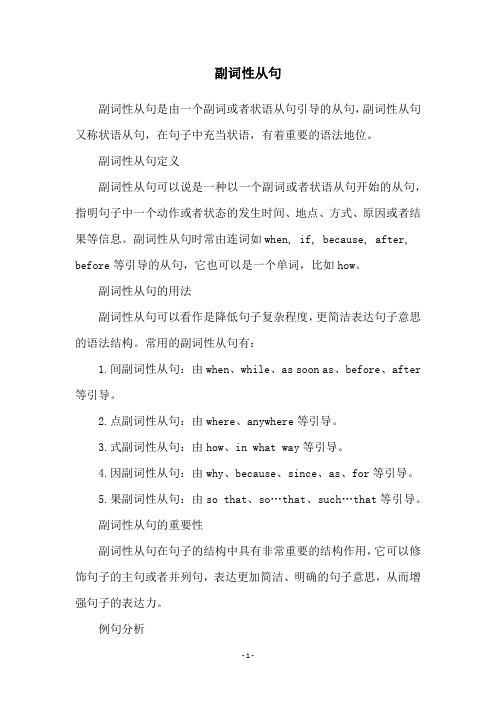
副词性从句副词性从句是由一个副词或者状语从句引导的从句,副词性从句又称状语从句,在句子中充当状语,有着重要的语法地位。
副词性从句定义副词性从句可以说是一种以一个副词或者状语从句开始的从句,指明句子中一个动作或者状态的发生时间、地点、方式、原因或者结果等信息。
副词性从句时常由连词如when, if, because, after, before等引导的从句,它也可以是一个单词,比如how。
副词性从句的用法副词性从句可以看作是降低句子复杂程度,更简洁表达句子意思的语法结构。
常用的副词性从句有:1.间副词性从句:由when、while、as soon as、before、after 等引导。
2.点副词性从句:由where、anywhere等引导。
3.式副词性从句:由how、in what way等引导。
4.因副词性从句:由why、because、since、as、for等引导。
5.果副词性从句:由so that、so…that、such…that等引导。
副词性从句的重要性副词性从句在句子的结构中具有非常重要的结构作用,它可以修饰句子的主句或者并列句,表达更加简洁、明确的句子意思,从而增强句子的表达力。
例句分析1.We can learn English well when we love it.这个句子中的副词性从句when we love it修饰了主句We can learn English well,表达了当我们热爱英语时才能学好英语的意思,这里的when引导的时间副词性从句,起到了修饰主句的重要作用。
2.She sings beautifully, which can make people happy.这个句子中的副词性从句which can make people happy用来修饰句子的主句She sings beautifully,表达了她唱歌美妙,可以让人感到高兴。
这里的which引导的结果副词性从句,起到了表达句意的重要作用。
副词从句和状语从句的不同

副词从句和状语从句的不同副词从句和状语从句是英语语法中常见的两种修饰句子或者补充句意的结构。
虽然它们都可以用来修饰动词、形容词或者副词,但是它们在构造和用法上有一些不同之处。
本文将从词法、语法以及句子结构等方面来探讨副词从句和状语从句的不同之处。
1. 词法差异副词从句通常由副词引导,比如when(当...时候)、where(在哪里)、how(如何)、why(为什么)等。
这些引导词本身就是副词,用来修饰动词、形容词或者副词。
状语从句的引导词则比较多样化,可以由连词引导,比如although (虽然)、because(因为)、if(如果)等,也可以由关系代词引导,比如who(谁)、which(哪个)等。
这些引导词本身既可以是代词也可以是连词,用来连接主句和从句。
2. 语法结构差异副词从句通常在句子中起状语的作用,修饰动词、形容词或者副词。
它们可以位于句首、句中或者句末,没有固定的位置要求。
例如:- When it rains, I prefer to stay at home.(当下雨时,我更喜欢待在家里。
)- He knows exactly how to solve the problem.(他准确地知道如何解决这个问题。
)状语从句也是用来修饰动词、形容词或者副词,它们通常在句子中起状语的作用。
与副词从句不同的是,状语从句的位置相对固定,通常位于主句之前或者之后。
例如:- Although he is tired, he keeps working.(虽然他很累,但他还在继续工作。
)- I will go if it doesn't rain.(如果不下雨的话,我会去的。
)3. 句子功能差异副词从句在句子中起到修饰或者限定的作用,用来说明时间、地点、方式、原因等。
它们提供了对主句进行补充或者解释的信息。
状语从句也是用来修饰或者限定主句,并提供额外的信息。
不同的是,状语从句更加注重因果关系或者条件关系。
英语中五大从句

五大从句英语中的五大从句包括名词性从句、形容词性从句、副词性从句、定语从句和状语从句。
以下是每种从句及其例句:1.名词性从句(Noun Clauses):●主语从句:What he said is true.(他说的是真的。
)●宾语从句:I believe that she will come.(我相信她会来。
)●表语从句:The problem is what to do next.(问题是下一步该怎么做。
)●同位语从句:Her announcement, that she was leaving,surprised everyone.(她宣布要离开,这让每个人都很吃惊。
)2.形容词性从句(Adjective Clauses):●关系代词引导的从句:The book that I bought is veryinteresting.(我买的书非常有趣。
)●关系副词引导的从句:I remember when we first met.(我记得我们第一次见面的时候。
)3.副词性从句(Adverbial Clauses):●时间从句:She called me before she left.(她离开前给我打了电话。
)●地点从句:I will meet you wherever you want.(我会在你想要的任何地方见你。
)●原因从句:He failed the exam because he didn't study.(他考试不及格是因为没有学习。
)●条件从句:If it rains, we will stay indoors.(如果下雨,我们将呆在室内。
)●结果从句:He worked hard, so he succeeded.(他努力工作,所以成功了。
)4.定语从句(Adjective Clauses):●关系代词引导的从句:The man who is talking to my mother ismy uncle.(正在和我妈妈交谈的那个人是我叔叔。
复合句—副词性从句——状语从句
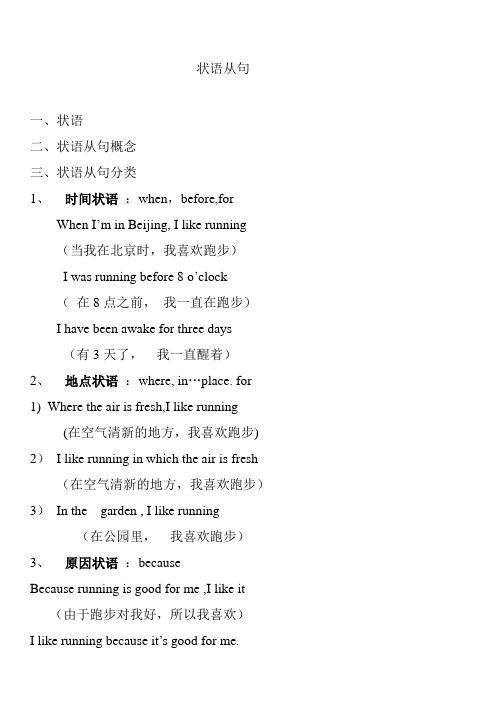
状语从句一、状语二、状语从句概念三、状语从句分类1、时间状语:when,before,forWhen I’m in Beijing, I like running(当我在北京时,我喜欢跑步)I was running before 8 o’clock(在8点之前,我一直在跑步)I have been awake for three days(有3天了,我一直醒着)2、地点状语:where, in…place. for 1)Where the air is fresh,I like running(在空气清新的地方,我喜欢跑步) 2)I like running in which the air is fresh (在空气清新的地方,我喜欢跑步)3)In the garden , I like running(在公园里,我喜欢跑步)3、原因状语:becauseBecause running is good for me ,I like it (由于跑步对我好,所以我喜欢)I like running because it’s good for me.(由于跑步对我好,所以我喜欢)4、目的状语:in order toIn order to be healthy ,I like running(为了健康,我喜欢奔跑)I like running in order to be healthy(为了健康,我喜欢奔跑)5、伴随状语:with n / doing, doing1) With the wind blowing ,I’m running(随着风在吹动,我在奔跑)2)I’m running with the wind blowing(随着风在吹动,我在奔跑)3)I’m running , seeing the bird .(看着鸟,我在奔跑)4)Seeing the bird, I’m running(看着鸟,我在奔跑)5)With the exception of singing,I also like running.(除了唱歌,我还喜欢奔跑)配题:Late in the afternoon a young man came along .He saw the stone , _saying ___(say )to himself .“The night will be very dark .Some neighbors will come along later in the dark and will fall against the stone .” --3)6、方式状语:by,throughI’m running ,by moving my legs.(通过摆动我的腿,我正在奔跑)7、条件状语:if,forIf the air is fresh, I will run(如果空气清新,我将会奔跑)For the English teaching, I’m OK.(对于英语教学,我是可以的)8 比较状语:thanI run farther than you(比起你,我跑得更快)I have less impact on the society than celebrities= I have less impact on the society than the impact of celebrities on the society (比起名人对于社会的影响力,我对于社会的影响力更小)9、让步状语: no matterNo matter how hard it is ,I will run.(无论多么艰难,我都要奔跑)10、结果状语:so that ,only to doI run so fast that I’m very tired(我跑得太快了以致使我非常疲惫)配题2014天津5. Anxiously, she took the dress out of the package and tried it on, only _to find _____ it didn’t fitA. to findB. foundC. findingD. having found。
副词从句总结知识点归纳
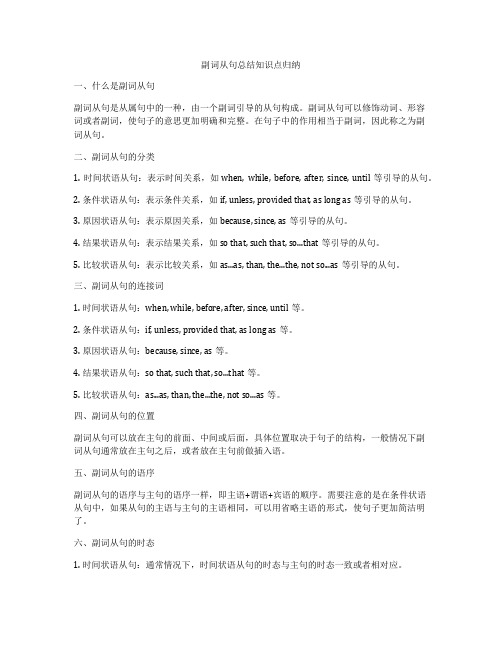
副词从句总结知识点归纳一、什么是副词从句副词从句是从属句中的一种,由一个副词引导的从句构成。
副词从句可以修饰动词、形容词或者副词,使句子的意思更加明确和完整。
在句子中的作用相当于副词,因此称之为副词从句。
二、副词从句的分类1. 时间状语从句:表示时间关系,如when, while, before, after, since, until等引导的从句。
2. 条件状语从句:表示条件关系,如if, unless, provided that, as long as等引导的从句。
3. 原因状语从句:表示原因关系,如because, since, as等引导的从句。
4. 结果状语从句:表示结果关系,如so that, such that, so...that等引导的从句。
5. 比较状语从句:表示比较关系,如as...as, than, the...the, not so...as等引导的从句。
三、副词从句的连接词1. 时间状语从句:when, while, before, after, since, until等。
2. 条件状语从句:if, unless, provided that, as long as等。
3. 原因状语从句:because, since, as等。
4. 结果状语从句:so that, such that, so...that等。
5. 比较状语从句:as...as, than, the...the, not so...as等。
四、副词从句的位置副词从句可以放在主句的前面、中间或后面,具体位置取决于句子的结构,一般情况下副词从句通常放在主句之后,或者放在主句前做插入语。
五、副词从句的语序副词从句的语序与主句的语序一样,即主语+谓语+宾语的顺序。
需要注意的是在条件状语从句中,如果从句的主语与主句的主语相同,可以用省略主语的形式,使句子更加简洁明了。
六、副词从句的时态1. 时间状语从句:通常情况下,时间状语从句的时态与主句的时态一致或者相对应。
副词性(状语)从句
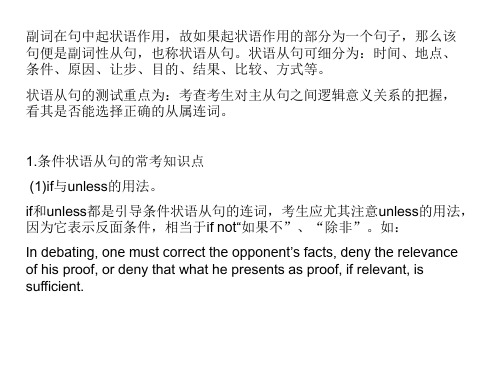
状语从句的测试重点为:考查考生对主从句之间逻辑意义关系的把握, 看其是否能选择正确的从属连词。
1.条件状语从句的常考知识点
(1)if与unless的用法。
2.让步状语从句的常考知识点
(1)as 引导让步从句,要求用倒装结构,把强调的部分置于句首。如: Much as he likes her, he does get irritated with her sometimes. Humble as it may be, there is no place like home.
(4)名词短语、介词短语each /every time, the moment/second/minute, in the time, by the time起连词作用。 如:I hope her health will have improved greatly by the time we come back next year. My pain must have been apparent the moment I walked into the room, for the first man I met asked sympathetically: “Are you feeling all right?” Mercury’s velocity is so much greater than the Earth’s that it completes more than four revolutions around the Sun in the time it takes the Earth to complete one.
英语语法 什么是副词性从句
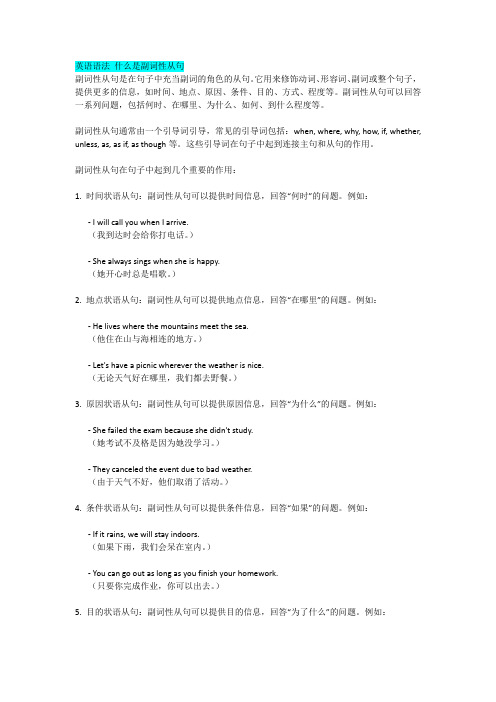
英语语法什么是副词性从句副词性从句是在句子中充当副词的角色的从句。
它用来修饰动词、形容词、副词或整个句子,提供更多的信息,如时间、地点、原因、条件、目的、方式、程度等。
副词性从句可以回答一系列问题,包括何时、在哪里、为什么、如何、到什么程度等。
副词性从句通常由一个引导词引导,常见的引导词包括:when, where, why, how, if, whether, unless, as, as if, as though等。
这些引导词在句子中起到连接主句和从句的作用。
副词性从句在句子中起到几个重要的作用:1. 时间状语从句:副词性从句可以提供时间信息,回答“何时”的问题。
例如:- I will call you when I arrive.(我到达时会给你打电话。
)- She always sings when she is happy.(她开心时总是唱歌。
)2. 地点状语从句:副词性从句可以提供地点信息,回答“在哪里”的问题。
例如:- He lives where the mountains meet the sea.(他住在山与海相连的地方。
)- Let's have a picnic wherever the weather is nice.(无论天气好在哪里,我们都去野餐。
)3. 原因状语从句:副词性从句可以提供原因信息,回答“为什么”的问题。
例如:- She failed the exam because she didn't study.(她考试不及格是因为她没学习。
)- They canceled the event due to bad weather.(由于天气不好,他们取消了活动。
)4. 条件状语从句:副词性从句可以提供条件信息,回答“如果”的问题。
例如:- If it rains, we will stay indoors.(如果下雨,我们会呆在室内。
)- You can go out as long as you finish your homework.(只要你完成作业,你可以出去。
状语从句和时间词如何用副词从句来表示时间
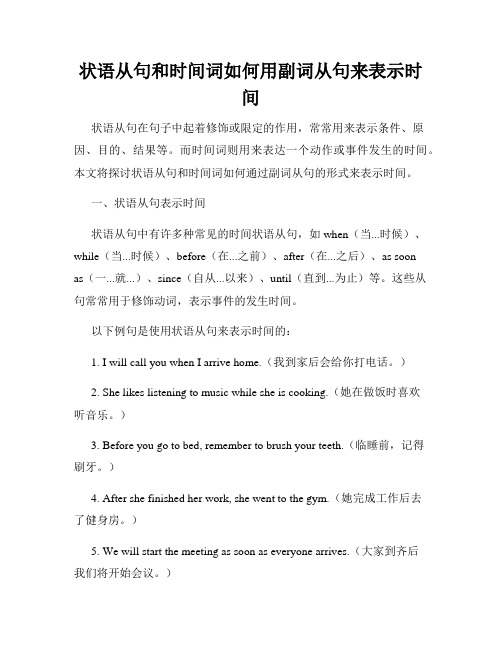
状语从句和时间词如何用副词从句来表示时间状语从句在句子中起着修饰或限定的作用,常常用来表示条件、原因、目的、结果等。
而时间词则用来表达一个动作或事件发生的时间。
本文将探讨状语从句和时间词如何通过副词从句的形式来表示时间。
一、状语从句表示时间状语从句中有许多种常见的时间状语从句,如when(当...时候)、while(当...时候)、before(在...之前)、after(在...之后)、as soonas(一...就...)、since(自从...以来)、until(直到...为止)等。
这些从句常常用于修饰动词,表示事件的发生时间。
以下例句是使用状语从句来表示时间的:1. I will call you when I arrive home.(我到家后会给你打电话。
)2. She likes listening to music while she is cooking.(她在做饭时喜欢听音乐。
)3. Before you go to bed, remember to brush your teeth.(临睡前,记得刷牙。
)4. After she finished her work, she went to the gym.(她完成工作后去了健身房。
)5. We will start the meeting as soon as everyone arrives.(大家到齐后我们将开始会议。
)neighborhood.(自从他搬到新小区,他每天早上慢跑。
)7. Please wait until I come back.(我回来之前请等一下。
)二、时间词引导的副词从句表示时间除了使用状语从句来表示时间外,我们还可以使用时间词引导的副词从句来表示时间。
这些时间词包括when(当...时候)、while(当...时候)、before(在...之前)、after(在...之后)、as soon as(一...就...)、since(自从...以来)、until(直到...为止)等。
状语从句是副词性从句
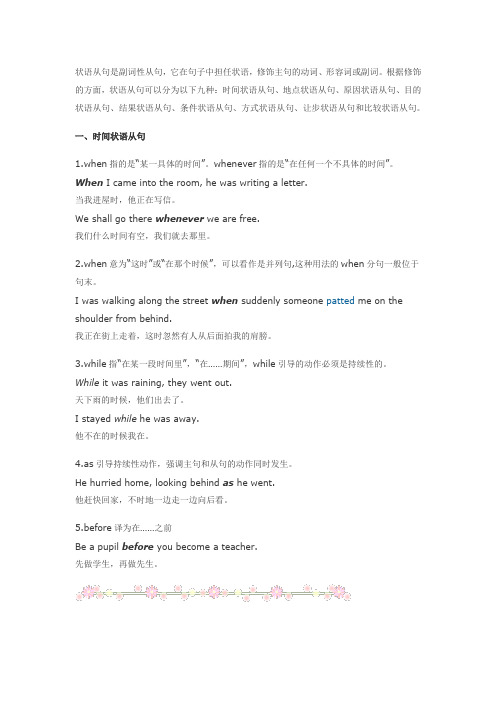
状语从句是副词性从句,它在句子中担任状语,修饰主句的动词、形容词或副词。
根据修饰的方面,状语从句可以分为以下九种:时间状语从句、地点状语从句、原因状语从句、目的状语从句、结果状语从句、条件状语从句、方式状语从句、让步状语从句和比较状语从句。
一、时间状语从句1.when指的是“某一具体的时间”。
whenever指的是“在任何一个不具体的时间”。
When I came into the room, he was writing a letter.当我进屋时,他正在写信。
We shall go there whenever we are free.我们什么时间有空,我们就去那里。
2.when意为“这时”或“在那个时候”,可以看作是并列句,这种用法的when分句一般位于句末。
I was walking along the street when suddenly someone patted me on the shoulder from behind.我正在街上走着,这时忽然有人从后面拍我的肩膀。
3.while指“在某一段时间里”,“在……期间”,while引导的动作必须是持续性的。
While it was raining, they went out.天下雨的时候,他们出去了。
I stayed while he was away.他不在的时候我在。
4.as引导持续性动作,强调主句和从句的动作同时发生。
He hurried home, looking behind as he went.他赶快回家,不时地一边走一边向后看。
5.before译为在……之前Be a pupil before you become a teacher.先做学生,再做先生。
6.after译为在……之后He arrived after the game started.比赛开始后,他到了。
7.如主句动词是持续性动作,常用肯定式,表示“直到……为止”。
状语从句
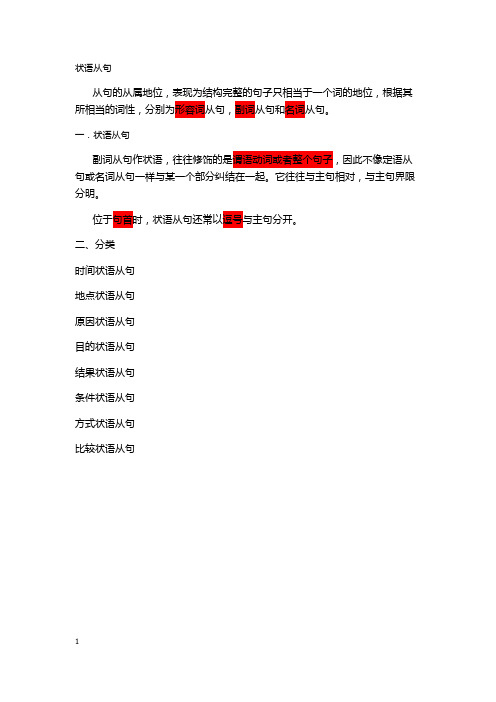
状语从句从句的从属地位,表现为结构完整的句子只相当于一个词的地位,根据其所相当的词性,分别为形容词从句,副词从句和名词从句。
一.状语从句副词从句作状语,往往修饰的是谓语动词或者整个句子,因此不像定语从句或名词从句一样与某一个部分纠结在一起。
它往往与主句相对,与主句界限分明。
位于句首时,状语从句还常以逗号与主句分开。
二、分类时间状语从句地点状语从句原因状语从句目的状语从句结果状语从句条件状语从句方式状语从句比较状语从句(一)时间状语从句A. When +持续动作\短暂动作While+持续型动作As------一边…,一边…..,B.一….就…..As soon as\immediately\directly\insatantly\the moment\the instant\no sooner…than…\hardy或scarcely…when…\once★注意---------①no sooner…+过去完成时+than…+一般过去时②N o sooner…+过去完成时(部分倒装)+than…+一般过去时C.till\until\not..untilTill、 Until -----主句的谓语动词为延续性才停止not..until ------主句的谓语动词为非延续性才开始强调和倒装Not until: 主句倒装Not until he saw his mother did the little boy smileD. Before\since①It will be+一段时间+before…还要多久才…..②It won’t be long before…. 过不了多久就……①It is….+since从句(一般过去时)②现在完成时\现在完成进行时+since 从句(一般过去时)E,every time\each time\next time \the first time\any time\all the time-----每当….\下次…..抽象Where 引导的定语从句和状语从句Eg.原因状语从句目的状语从句条件状语从句方式状语从句让步状语从句。
- 1、下载文档前请自行甄别文档内容的完整性,平台不提供额外的编辑、内容补充、找答案等附加服务。
- 2、"仅部分预览"的文档,不可在线预览部分如存在完整性等问题,可反馈申请退款(可完整预览的文档不适用该条件!)。
- 3、如文档侵犯您的权益,请联系客服反馈,我们会尽快为您处理(人工客服工作时间:9:00-18:30)。
副词从句
一、什么是副词从句
二、副词从句与对等从句的比较
三、副词从句的种类
1、时间
2、地点
3、条件
4、原因
5、结果
6、目的
7、让步
8、比较
9、方式
一、时间状语从句
常用引导词:when,as,while,as soon as,before,after,since,not....until
特殊引导词:the minute,the moment,the second,every time,the day,the instant
I didn't realize how special my mother was until I became an adult.
直到我成为了一个成年人我才意识到我的母亲是多么的特殊。
While John was watching TV, his wife was cooking.
当约翰看电视时,他的妻子正在做饭。
Every time I listen to your advice, I get into trouble.
每当我听取你的建议时,我就会惹上麻烦。
二、地点状语从句
常用引导词:where
特殊引导词:wherever,anywhere,everywhere
Generally, air will be heavily polluted where there are factories.
一般来说,有工厂的地方空气污染就严重。
Wherever you go, you should work hard.
无论你去哪里,你都应该努力工作。
三、原因状语从句
常用引导词:because,since,as,
特殊引导词:seeing that,now that,in that,considering that,given that.
My friends dislike me because I'm handsome and successful.
我的朋友都不喜欢我,因为我又英俊又成功。
Now that everybody has come, let's begin our conference.
既然每个人都到了,让我们开始我们的会议吧。
The higher income tax is harmful in that it may discourage people from trying to earn more.
更高的收入税是有害的,因为它或许会阻碍人们努力赚钱。
四、目的状语从句
常用引导词:so that,in order that
特殊引导词:lest,in case,for fear that,in the hope that,for the purpose that The boss asked the secretary to hurry up with the letters so that he could sign them. 老板要求秘书快写函件以便他能在上面签字。
The teacher raised his voice on purpose that the students in the back could hear more clearly.
为了让后面的学生听得更清楚,老师有意地提高了他的声音。
注意,由for引导的是一个并列句,不是原因状语从句,但有表原因的意思,是并列连词五、结果状语从句
常用引导词:so…that,such…that…
特殊引导词:such that,to the degree that,to the extent that,to such a degree th at…
He got up so early that he caught the first bus.
他很早起床以便赶上第一班公共汽车
It's such a good chance that we must not miss it.
这是一个好机会,千万不能错过它
To such a degree was he excited that he couldn't sleep last night.
他激动到这个程度,以至于他昨晚睡不着
六、条件状语从句
常用引导词:if,unless,whether(whether...or not)
特殊引导词:as/so long as,only if,providing/provided that,supposing that,in case…
We'll start our project if the president agrees.
如果总统同意,我们将开始我们的项目
You will certainly succeed so long as you keep on trying.
只要你继续努力,你一定会成功的。
Provided that there is no opposition, we shall hold the meeting here.
如果没有人反对,我们就在这里开会。
七、让步状语从句
常用引导词:though,although,even if,even though
特殊引导词:in spite of the fact that,whatever,whoever,wherever,whenever,however
Much as I respect him, I can't agree to his proposal.
尽管我很尊敬他,但是我却不同意他的建议。
The old man always enjoys swimming even though the weather is rough. 老人都很喜欢游泳,即使天气很恶劣。
He won't listen whatever you may say.
他不会听你说什么。
八、比较状语从句
常用引导词:as,than
特殊引导词:the more … the more …,just as …
She is as bad-tempered as her mother.
她和她妈妈一样脾气很坏。
The more you exercise, the healthier you will be.
你运动的越多,你就越健康。
Food is to men what oil is to machine.
食物之于人,犹如油之于机器。
九、方式状语从句
常用引导词:as,as if…
特殊引导词:the way…
When in Rome, do as the Romans do.
入国问禁,入乡随俗。
She behaved as if she were the boss.
她表现得好像她是老板。
Sometimes we teach our children the way our parents have taught us. 有时,我们用父母教导我们的方式教导我们的孩子
四、注意点
1、从句在前,用逗号与主句分开。
